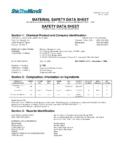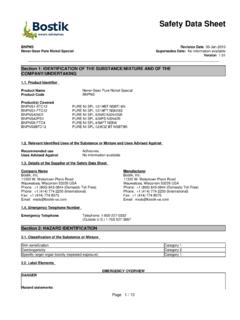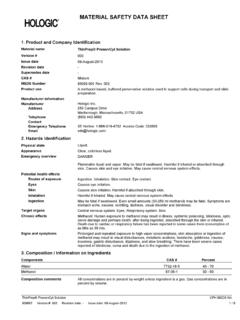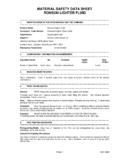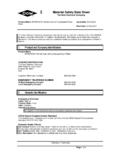Transcription of Praxair Material Safety Data Sheet - Green Air Supply
1 Product: Nitrogen, Compressed P-4631-H Date: July 2007. Praxair Material Safety data Sheet 1. Chemical Product and Company Identification Product Name: Nitrogen, compressed (MSDS No. Trade Names: Nitrogen, Medipure . P-4631-H) Nitrogen, Extendapak Nitrogen, Chemical Name: Nitrogen Synonyms: Dinitrogen, Refrigerant R728. Chemical Family: Permanent gas Product Grades: , , SPG; VEZ; UHP; Bev; Extendapak ; NF , MD; OF; Z; VOCF; UZAM;. ECD; Research; Industrial, , LaserStar; TA. Telephone: Emergencies: 1-800-645-4633* Company Name: Praxair , Inc. CHEMTREC: 1-800-424-9300* 39 Old Ridgebury Road Routine: 1-800- Praxair Danbury, CT 06810-5113.
2 * Call emergency numbers 24 hours a day only for spills, leaks, fire, exposure, or accidents involving this product. For routine information, contact your supplier, Praxair sales representative, or call 1-800- Praxair (1-800-772-9247). 2. Hazards Identification EMERGENCY OVERVIEW. CAUTION! High-pressure gas. Can cause rapid suffocation. May cause dizziness and drowsiness. Self-contained breathing apparatus may be required by rescue workers. Under ambient conditions, this a colorless, odorless, inert gas. OSHA REGULATORY STATUS: This Material is considered hazardous by the OSHA Hazard Communications Standard (29 CFR ).
3 POTENTIAL HEALTH EFFECTS: Effects of a Single (Acute) Overexposure Inhalation. Asphyxiant. Effects are due to lack of oxygen. Moderate concentrations may cause headache, drowsiness, dizziness, excitation, excess salivation, vomiting, and unconsciousness. Lack of oxygen can kill. Skin Contact. No harm expected. Swallowing. An unlikely route of exposure. This product is a gas at normal temperature and pressure. Eye Contact. No harm expected. Effects of Repeated (Chronic) Overexposure. No harm expected. Other Effects of Overexposure. Asphyxiant. Lack of oxygen can kill. Copyright 1980, 1983, 1985, 1992, 1997, 2001, 2004, 2007, Praxair Technology, Inc.
4 Page 1 of 8. All rights reserved. A vertical line in the left margin indicates revised or new Material . Product: Nitrogen, Compressed P-4631-H Date: July 2007. Medical Conditions Aggravated by Overexposure. The toxicology and the physical and chemical properties of nitrogen suggest that overexposure is unlikely to aggravate existing medical conditions. CARCINOGENICITY: Nitrogen is not listed by NTP, OSHA, or IARC. POTENTIAL ENVIRONMENTAL EFFECTS: None known. For further information, see section 12, Ecological Information. 3. Composition/Information on Ingredients See section 16 for important information about mixtures.
5 COMPONENT CAS NUMBER CONCENTRATION. Nitrogen 7727-37-9 >99%*. *The symbol > means greater than.. 4. First Aid Measures INHALATION: Remove to fresh air. If not breathing, give artificial respiration. If breathing is difficult, qualified personnel may give oxygen. Call a physician. SKIN CONTACT: An unlikely route of exposure. This product is a gas at normal temperature and pressure. SWALLOWING: An unlikely route of exposure. This product is a gas at normal temperature and pressure. EYE CONTACT: An unlikely route of exposure. This product is a gas at normal temperature and pressure.
6 NOTES TO PHYSICIAN: There is no specific antidote. Treatment of overexposure should be directed at the control of symptoms and the clinical condition of the patient. 5. Fire Fighting Measures FLAMMABLE PROPERTIES: Nitrogen cannot catch fire. SUITABLE EXTINGUISHING MEDIA: Nitrogen cannot catch fire. Use media appropriate for surrounding fire. PRODUCTS OF COMBUSTION: Not applicable. PROTECTION OF FIREFIGHTERS: CAUTION! High-pressure gas. Asphyxiant. Lack of oxygen can kill. Evacuate all personnel from danger area. Immediately deluge cylinders with water from maximum distance until cool; then move them away from fire area if without risk.
7 Shut off flow if you can do so without risk. Self-contained breathing apparatus may be required by rescue workers. On-site fire brigades must comply with OSHA 29 CFR Specific Physical and Chemical Hazards. Heat of fire can build pressure in cylinder and cause it to rupture. No part of cylinder should be subjected to a temperature higher than 125 F. (52 C). Nitrogen cylinders are equipped with a pressure relief device. (Exceptions may exist where authorized by DOT.). Protective Equipment and Precautions for Firefighters. Firefighters should wear self- contained breathing apparatus and full fire-fighting turnout gear.
8 Page 2 of 8. Product: Nitrogen, Compressed P-4631-H Date: July 2007. 6. Accidental Release Measures STEPS TO BE TAKEN IF Material IS RELEASED OR SPILLED: CAUTION! High-pressure gas. Personal Precautions. Asphyxiant. Lack of oxygen can kill. Evacuate all personnel from danger area. Use self-contained breathing apparatus where needed. Shut off flow if you can do so without risk. Ventilate area or move cylinder to a well-ventilated area. Test for sufficient oxygen, especially in confined spaces, before allowing reentry. Environmental Precautions. Prevent waste from contaminating the surrounding environment.
9 Keep personnel away. Discard any product, residue, disposable container, or liner in an environmentally acceptable manner, in full compliance with federal, state, and local regulations. If necessary, call your local supplier for assistance. 7. Handling and Storage PRECAUTIONS TO BE TAKEN IN HANDLING: Protect cylinders from damage. Use a suitable hand truck to move cylinders; do not drag, roll, slide, or drop. Never attempt to lift a cylinder by its cap; the cap is intended solely to protect the valve. Never insert an object ( , wrench, screwdriver, pry bar) into cap openings; doing so may damage the valve and cause a leak.
10 Use an adjustable strap wrench to remove over-tight or rusted caps. Open valve slowly. Close valve after each use; keep closed even when empty. If valve is hard to open, discontinue use and contact your supplier. For other precautions in using nitrogen, see section 16. PRECAUTIONS TO BE TAKEN IN STORAGE: Store and use with adequate ventilation. Always secure cylinders upright to keep them from falling or being knocked over. Install valve protection cap, if provided, firmly in place by hand. Store only where temperature will not exceed 125 F (52 C). Store full and empty cylinders separately.
